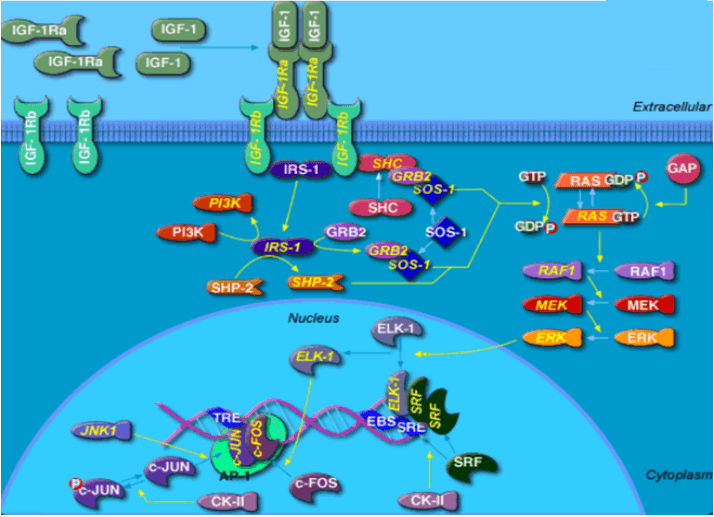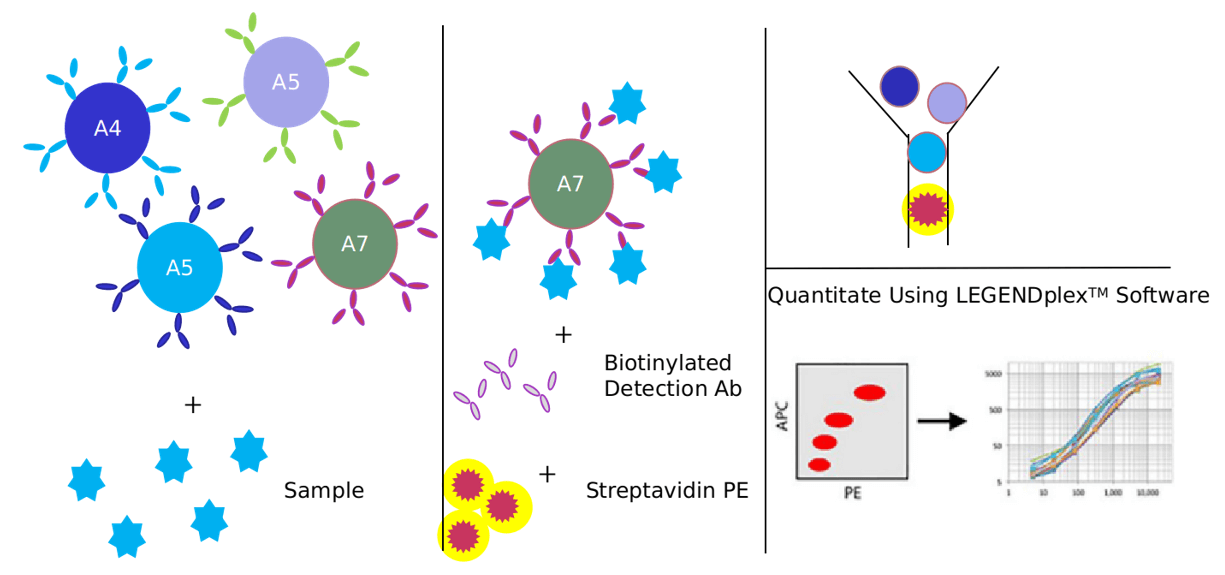IGF-1 signaling pathway
Based on Luminex technology platform, Creative Proteomics provides analysis services for key targets of IGF-1 signaling pathway.
 (Maki RG, et al. 2019)Insulin-like growth factor 1 (IGF-1) and its receptor (IGF-1R) provide a powerful proliferative signaling system that stimulates the growth of many different cell types and prevents apoptosis. In vivo, IGF-1 acts as an intermediate in many growth hormone responses and stimulates the growth of certain types of cancer. igf-1 also provides a mitogenic signal that acts as a growth factor for many tissue culture cells. one component of IGF-1 mitogenic signaling is the association of receptor tyrosine kinases with Shc, Grb2, and Sos-1 to activate the ras and Map kinase cascades (raf, Mek, Erk). phosphorylation of IRS-1 and activation of PI3 kinase are also involved in IGF-1 signaling, similar to insulin signaling.
(Maki RG, et al. 2019)Insulin-like growth factor 1 (IGF-1) and its receptor (IGF-1R) provide a powerful proliferative signaling system that stimulates the growth of many different cell types and prevents apoptosis. In vivo, IGF-1 acts as an intermediate in many growth hormone responses and stimulates the growth of certain types of cancer. igf-1 also provides a mitogenic signal that acts as a growth factor for many tissue culture cells. one component of IGF-1 mitogenic signaling is the association of receptor tyrosine kinases with Shc, Grb2, and Sos-1 to activate the ras and Map kinase cascades (raf, Mek, Erk). phosphorylation of IRS-1 and activation of PI3 kinase are also involved in IGF-1 signaling, similar to insulin signaling.
The IGF-1 signaling pathway regulates the growth and development of embryonic tissues and various tissues after birth. In terms of pathophysiology, the IGF-1 signaling pathway provides a new intracellular signaling mechanism, thus providing new ideas for the prevention and treatment of diseases in which ICF-1 is involved in cell proliferation as the main pathological alteration.
IGF-1 signaling pathway has endocrine, autocrine and paracrine properties, which can mimic some biological effects of GH, promote cell proliferation and differentiation, promote cell growth and inhibit apoptosis. It also has insulin-like metabolic activity and immunomodulatory effects.
Our detectable targets:
| VPS34 | UYRAG | PDHK | PROLC3 | NFκB | Vav |
| PKR | Bax | LC3I | ULK | RIG-1 | TBK1 |
| ISRE | VDAC | Grb2 | FIP200 | TRAF3 | mTOR |
| Erk1 | ANT | TLR3 | PI3K | TRIF | MSK1 |
| PHGDH | LDHA | Tak1 | p50 | IRAK1 | p65 |
| PFK | LKB1 | p38 | p53 | p38MAPK | MSK2 |
| ULK1 | Shc | AMBRA1 | TRAM | SH2 | MEK6 |
| TRAF5 | c-Myc | ISGF3 | Shp-2 | TRAF6 | IRS1 |
| RIP1 | PTP | CAP | IRF5 | MEK3 | IRSI-4 |
Technology platform:
We provide Luminex technology for IGF-1 signaling pathway analysis.
Luminex technology is a multifunctional liquid phase analysis platform, which is developed on the basis of high-speed digital signal processing technology, colored microspheres, applied fluidics and laser technology. The core is the use of fluorescent dyes for encoding. By adjusting the different ratios of different fluorescent dyes, more than 100 microspheres with different fluorescence spectra were obtained. The reactions are carried out on microspheres with different fluorescent codes, such as nucleic acid hybridization, antigen-antibody, enzyme-substrate, ligand-receptor binding reactions. Using laser detection technology, qualitative and quantitative analysis of microsphere encoding and reporting fluorescence.
Advantages of IGF-1 signaling pathway detection:
- High sensitivity: The surface area of the microspheres is large, and 100,000 probes can be fixed on each microsphere, which ensures the maximum binding with the target molecules in the sample and improves the detection sensitivity. The lowest detection concentration can reach 0.1 pg/mL.
- Strong specificity: Can read the fluorescent signal on a single microsphere, and automatically distinguish between bound and unbound microspheres.
- High accuracy: Without washing, the fluorescence intensity of the reporter molecule on the microsphere is proportional to the bound molecule to be detected. Because the detection range of the Luminex detection platform is large, it does not need to be diluted like ELISA detection, which further reduces errors.

Application of our service:
- Study the regulatory mechanism of IGF-1 signaling pathway in clinical diseases
- Study the influence of various human viruses on the IGF-1 signaling pathway
- Study the influence of carcinogenic drugs or therapies on the signal pathway of IGF-1
Creative Proteomics has developed a signal pathway target detection platform. We are not limited to providing IGF-1 signal path detection services, but can also provide other signal path detection services. If you want to detect other targets, please contact us and we will customize the service for you. Look forward to working with you.
References:
- Maki RG. Small is beautiful: insulin-like growth factors and their role in growth, development, and cancer. Clin Oncol, 2019, 28(33): 4985–4995.
- Samani AA, Yakar S, et al. The role of the IGF system in cancer growth and metastasis: overview and recent insights. Endocr Rev, 2017, 28(1): 20–47.
- Liao Y, Abel U, et al. Up-regulation of insulin-like growth factor axis components in human primary prostate cancer correlates with tumor grade. Hum Pathol, 2018, 36(11): 1186–1196.



